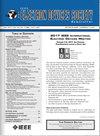半导体器件异质结构中ZnO界面工程实现MoS 2的N/P掺杂
IF 2.4
3区 工程技术
Q3 ENGINEERING, ELECTRICAL & ELECTRONIC
引用次数: 0
摘要
本研究的目的是探索MoS2/ZnO异质结构的电子特性及其在半导体器件中的潜在应用。利用密度泛函理论-非平衡格林函数(DFT-NEGF)分析了N/P掺杂对不同端部ZnO结构电子性能的影响。h -钝化处理显著影响掺杂,能够精确调整界面电荷分布以改善电学性能。此外,在不同的间隔长度下,掺杂二硫化钼器件的输运特性得到了显著改善。特别是在弹道输运条件下,与未掺杂器件相比,掺杂器件的电流增加了大约四个数量级。这些发现对基于二维材料的高性能电子器件的设计和优化具有重要的理论和实践意义。本文章由计算机程序翻译,如有差异,请以英文原文为准。
Achieving N/P Doping of MoS₂ Through ZnO Interface Engineering in Heterostructures for Semiconductor Devices
The aim of this study is to explore the electronic properties of the MoS2/ZnO heterostructure and their potential applications in semiconductor devices. We analyzed the impact of N/P doping on electronic properties of ZnO structures with different terminations using the Density Functional Theory-Non-Equilibrium Green’s Function (DFT-NEGF). H-passivation treatment significantly affects doping, enabling precise adjustment of interface charge distribution for improved electrical performance. Additionally, the transport properties of doped MoS2 devices have been significantly improved at different spacer lengths. Particularly under ballistic transport conditions, the current of the doped devices has increased by approximately four orders of magnitude compared to the undoped devices. These findings have important theoretical and practical implications for the design and optimization of high-performance electronic devices based on two-dimensional materials.
求助全文
通过发布文献求助,成功后即可免费获取论文全文。
去求助
来源期刊

IEEE Journal of the Electron Devices Society
Biochemistry, Genetics and Molecular Biology-Biotechnology
CiteScore
5.20
自引率
4.30%
发文量
124
审稿时长
9 weeks
期刊介绍:
The IEEE Journal of the Electron Devices Society (J-EDS) is an open-access, fully electronic scientific journal publishing papers ranging from fundamental to applied research that are scientifically rigorous and relevant to electron devices. The J-EDS publishes original and significant contributions relating to the theory, modelling, design, performance, and reliability of electron and ion integrated circuit devices and interconnects, involving insulators, metals, organic materials, micro-plasmas, semiconductors, quantum-effect structures, vacuum devices, and emerging materials with applications in bioelectronics, biomedical electronics, computation, communications, displays, microelectromechanics, imaging, micro-actuators, nanodevices, optoelectronics, photovoltaics, power IC''s, and micro-sensors. Tutorial and review papers on these subjects are, also, published. And, occasionally special issues with a collection of papers on particular areas in more depth and breadth are, also, published. J-EDS publishes all papers that are judged to be technically valid and original.
 求助内容:
求助内容: 应助结果提醒方式:
应助结果提醒方式:


